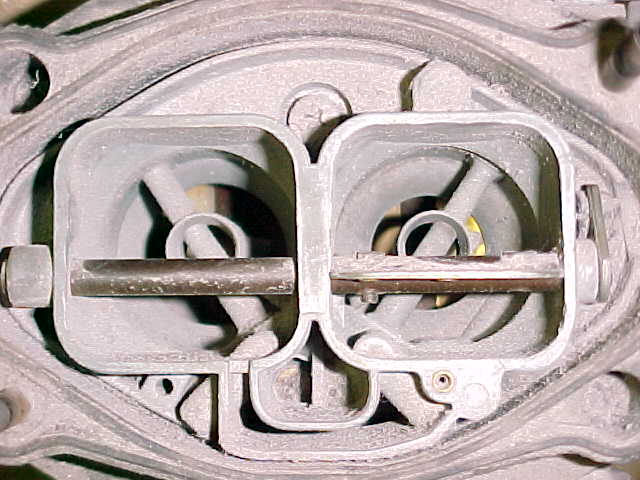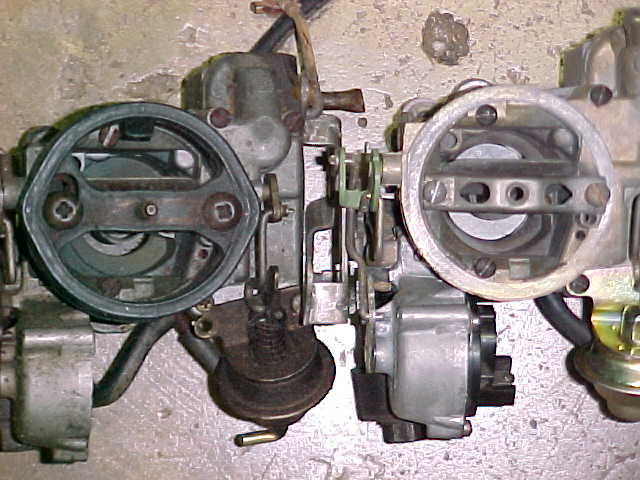

Click on photos to enlarge
Chevette
carburetor* icing subject
( *or any other carburetor )
I have noted that this subject comes up from time to time, and I have decided to provide a page explaining why carburetor icing occurs, and how to stop/cure it. For whatever reason, I have not heard of a carburetor icing problem for years, but when I became interested in Chevette's, much to my amazement, it seems to be common.
A carburetor ices up when a cold environment exists, and air rushing through the venturi(s) causes ice to form on the venturi, choking off the flow of air into the engine. Ice will form on the cold surface due to inadequate heating of the carburetor casting, inadequate heating of the incoming air, and/or high moisture ( humidity ) content of the air. An "iced up" Chevette carburetor can be seen here. Air rushing through the venturi is moving at very high speeds, and icing can form at temps as high as 40° under some instances. You are probably aware of the "wind chill" factor that your weather person is always mentioning. Well, the inside of a venturi is a veritable tornado of "wind chill", and under the right circumstances, icing can occur.
***************************************************************************************
Update: A couple of pretty smart
guys have taken issue with my "wind chill" wording. Although I was never
comfortable with it in the first place, it seemed a reasonable "interpretation"
for what was occuring in the carburetor venturi without going into a much more detailed
discussion. I see now that this was a mistake not to include more details. I will be
amending the text ( or not :-) when I get time to be more precise in my explanation,
which will include the principals of lowered atmospheric pressure contributing to the
formation of ice.
( from Mr. Al Savage: On carburetor
icing: gases generate heat when compressed (actually this is how diesels ignite the
fuel/air mixuture). But the opposite is also true: when you lower the pressure of a
gas, it absorbs heat. This, and
not wind chill, is the primary reason for ice formation at the venturi of a carburetor in
humid weather.
> > . . . when you lower the pressure of a gas, it absorbs heat. This, and
not wind chill, is the primary reason for ice formation at the venturi of a carburetor in
humid weather.Wind chill factor is negligible in venturi ice formation; the air gets
colder because it's being rarified (I think that's the term; the term for "opposite
of compressed" is what I'm looking for here). I'm no Physics major, and high
school science was a long time ago . . . )
*****************************************************************************************
Frankly, carburetor icing was cured years ago, when air cleaner inlets became connected to a hot air source, usually a tube coming off of the exhaust manifold. Incoming air is drawn from the baffle attached to the exhaust manifold, directed up a hot air tube, into the snorkel of the air cleaner, and into the carburetor. There is a thermal valve ( Thermactor ) located in the air cleaner snorkel that engages below a certain engine temperature, and closes off the snorkel to outside air, allowing heated air into the carburetor. This flap MUST be closed below a certain temperature, or the heated air will not be drawn into the air cleaner case.
Also, factory carbs are heated below via some kind of exhaust cross-over which warms the area under the carburetor, promoting rapid vaporization of the air-fuel mixture. Later model Chevette's also have a heated grid under the carb ( EFE plate ) which frankly is near useless. It will not cure carburetor icing, this occurs much higher in the carb venturi. The EFE plate frequently malfunctions, or the grid breaks off or clogs, and as a device intended to heat incoming air-fuel mixtures, I don't personally believe it was ever very successful. It certainly doesn't stand up to years of usage, and most people don't bother to re-install them. They are also restrictive of air flow.
As I previously stated, vaporization of the air-fuel mixture is critical for engine operation, especially when cold. It is common knowledge that a cold air intake will provide more power because cold air is much more dense. However, for maximum driveability of a street car, it is not practical to introduce cold air when the temperature is much below 50°. Fuel droplets tend to drop out of suspension when cold, and will in some cases puddle in the intake manifold. Hot vaporized fuel is more likely to make the sharp turns inside an intake manifold, and much easier to ignite in the combustion chamber. Leave the cold air intakes for the summer, and to race cars. This is another topic.
The driveability of an engine with a heated air intake in cold temperatures is
dramatically better, as opposed to a poorly tuned engine with cold air introduced either
on purpose, or by a malfunctioning hot air system.
******************************************************************************
( An anecdotal aside......
One of my cars is a 1979 Chevrolet Caprice Classic that has been semi-highly modified. It
has a 400 small block Chev engine that I installed in it, with a dual snorkel cold air
inlet system. In warm weather, I allow air to be drawn into the carburetor through the two
huge cold air tubes, and this engine never "dogs" down on a hot summer day,
because it is getting outside air at whatever temperature that may be, as opposed to
underhood air, which can go well over 200°. Even 90° air is better than 200° ! However,
in the fall, if I forget to connect the vacuum line that closes off the cold air snorkels,
I am quickly reminded by extremely poor driveability. I have a system that easily allows
me to provide this quickly. The flaps in the snorkels are open by default, and when you
provide vacuum to the valves, they close off the cold air, drawing heated air into the air
cleaner case. I simply connect the vacuum lines in cold weather, and the snorkels are
closed off to cold air. At WOT throttle, they open by default, because vacuum drops
to zero, allowing a huge gulp of extra cold air for performance. I didn't bother
with a thermal switch, I don't care. I wanted the cold air cut off most of the time, as
this REALLY improves driveability, and fuel mileage. Besides, I run extra lean air-fuel
mixtures, and the car is undriveable without heated air. With the heated air, the car is
fine.
Also, years ago, on a Chevrolet pick-up I had, I was driving down the highway, and the
engine was loosing power dramatically. I had to pull over, and realized that the carb had
iced up because of the huge cold air tube I had installed. It wasn't very cold that day,
but the cold air tube was right behind the grille, and it was freezing the inside of the
Q-jet carb. Pulled off tube, went on my way. )
**********************************************************************************
Getting back to the problem of the Chevette's icing up, I can only assume that
this subject comes up frequently because of a couple of things. People are neglecting the
operation and importance of the hot air tube system, and have removed or disabled it, and
the design of the Chevette carbs, either Rochester 1ME or the Holley 5210/6510 which will
inadvertently promote icing without the heated air intake. Please take note of the
following pictures:


Click on photos to enlarge
Note that the Chevette Holley 6510 on the left has an extremely small primary venturi ( on the right ). Note the Chevette Rochester 1ME in the right picture, left carburetor, also has an extremely small venturi, as opposed to the much larger venturi of the Rochester 1ME for a 1977 Chevrolet 250 6 cylinder engine. While this promotes better throttle response on the very small Chevette engine, it will also keep air flow velocity very high, which quite possibly is contributing to the high instances of carburetor icing complaints of Chevette owners. At highway cruising speeds, very high air flow, coupled with an unheated air intake will allow ice to form on the venturi, and this will quickly block off incoming air into the engine. Since the venturi is so very small in these engines, I suspect that this is what is happening in a lot of cases. However, the factory air cleaner intake system, when properly functioning, will prevent this from occurring.
Bottom line, fix the factory air cleaner system, especially in cold weather, and your carburetor icing problems will be solved. But, even more importantly, your driveability and fuel mileage will be greatly enhanced. Hot vaporized fuel "lights off" much easier than cold fuel with large droplets. Hot vaporized fuel will significantly improve driveability, fuel mileage, and reduce emissions drastically. Cold air is undoubtedly better for maximum performance, but there is a point on a street engine where FROZEN air reduces driveability to zero, because you're stalled by the side of the road waiting for the carburetor to unthaw. Cold air for horsepower really doesn't apply to really really cold air, just an inlet temperature that is appropriate for the job of an engine. If the engine is a Winston Cup stock car, "cold" air is drawn from the base of the windshield, and I don't think that these cars race on the frozen tundra that some people drive on to work with their freezing Chevette's ! :-) Also, racing carburetors rarely have the extremely small venturi's that the Chevette uses, and racing engines are operated at a different level than a throttled street engine. This allows Winston Cup stock cars to operate even when the temps are somewhat colder than ideal for racing during spring and fall races. Also, provisions are made for cold temperature race cars, like the ice racing Chevette's.
( If anyone would like to provide me with a detailed photograph of the Chevette heated air cleaner system, I would appreciate it, post the pictures, and make note of your contribution ! )
( The text and images contained herein is the property of Watts Carburetion ServiceŽ, and may not be reproduced without permission. The information is provided freely, and without responsibility for any mis-conceptions or damage that may occur from dissemination of this data. The author's only intent is to provide helpful information about a particular subject, and no other implications should be inferred from this. All attempts were made to provide accurate, factual information, and this information is known to be correct.)